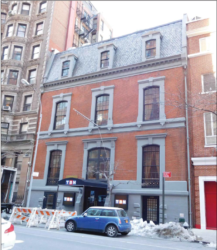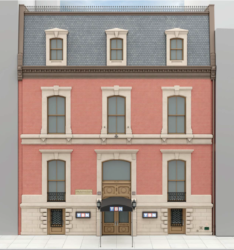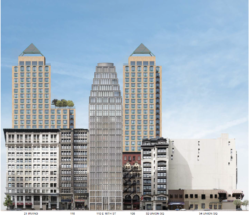
Current condition of the Century Building. Image credit: LPC
In exchange for bulk waivers for 16th Street development Tishman Realty will restore and maintain the Century Association Building. At its meeting on September 12, 2017, the Landmarks Preservation Commission revisited an application by Tishman Realty to create a restoration and maintenance plan for the individually landmarked Century Association Building as part of a 74-711 special permit application to City Planning. The City Planning application entails the redevelopment of an adjoining lot at 110 East 16th Street, replacing an 84-foot-high 1960s garage with a new 283-foot-tall mixed use building. The building, designed by Morris Adjmi, will host residential, retail, and garage uses requiring bulk waivers. In a 74-711 application, Landmarks must approve the restoration and maintenance work, and submit a finding that the new development would relate harmoniously to the landmark.
The 1869 landmarked Century building, at 109 East 15th Street, was designed by Gabrill & Richardson, and is thought to be the City’s oldest purpose-built clubhouse.
At the Landmarks’ meeting on July 18, 2017, commissioners struggled with the amount of bulk sought for the restoration of a building already in fairly good condition. Chair Meenakshi Srinivasan and Counsel Mark Silberman stressed that it was not a “quid pro quo” relationship, and determinations about the appropriateness of the development’s bulk were City Planning’s to consider. Some commissioners also found that the extent of the restoration was insufficient, asking the applicant to examine the feasibility of restoring or recalling a pre-1930s fenced areaway, and steps and stoops at the ground floor entrances. Srinivasan laid over a vote on the matter, requesting that the applicants explore further restoration options.

Rendering of the proposed restoration of the Century Building. Image credit: LPC
At the September 12th meeting, Higgins Quasebarth consultant Cas Stachelberg noted that the development’s impact on the landmark was mitigated by distance, standing 103 feet away from the Century Club’s facade. Stachelberg said the tower’s arrangement, with a limestone base, brick-faced shaft and metal-clad roof, was inspired by the materials and mansard roof of the Club. Because the new building and the landmark are not adjacent to one another, the entirety of both would not be included in any public view. The top of a new tower would be visible behind the Club.
The restoration plan for the Club was modified in light of commissioner comments, and now included work at the building’s rear where slate shingles would be restored and dormers replaced. Taller doors would be installed at the entry recalling historic proportions. Facade brick would be repointed, and coated sandstone at the base would be restored to its natural condition. Cresting at the cornice would be reinstalled. Stachelberg said the base could not be restored to its original condition, with arched windows and doors, because of egress requirements.
Chair Srinivasan found that the applicants had proposed “a much more full restoration plan,” that would reverse “unfortunate” alterations to the landmark. Srinivasan said the new tower would function harmoniously as a “backdrop building” with the Club. Commissioner Fred Bland generally concurred, but questioned the number, size and style of signs for the television studio that now occupies the Club.
Commissioner Michael Goldblum continued to express reservations about the massive increase in scale being sought through the 74-711 process, and whether the tower would interact harmoniously with the landmark. He said the new development should be “retrained in its visibility” in relation to the Club, and did not meet the requirements of the waiver. Commissioner Adi Shamir-Baron commented that any harmony between the two buildings was purely “transactional,” with the development funding the maintenance plan and the landmark allowing the development’s bulk.

Rendering of the proposed new tower at 110 East 16th Street. Image credit: LPC
Srinivasan again asserted that the scale of the development under waiver was not Landmark’s issue to address, but City Planning’s.
Landmarks voted to approve the restoration work and issue a favorable report to City Planning regarding the waivers, with Commissioner Goldblum dissenting on the report. The Certificate of Appropriateness was modified to mandate that the signs on the Club’s facade be more consistent with historic signage.
LPC: (Former) Century Association Building, 109 East 15th Street, Manhattan (19-1169) (Sept. 12, 2017).
By: Jesse Denno (Jesse is a full-time staff writer at the Center for NYC Law).

